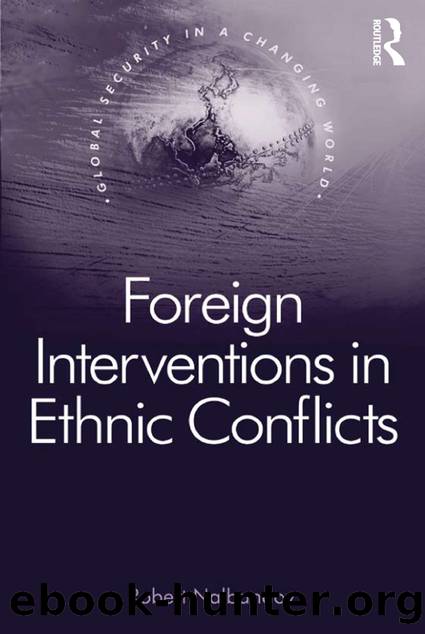Foreign Interventions in Ethnic Conflicts by Robert Nalbandov

Author:Robert Nalbandov [Nalbandov, Robert]
Language: eng
Format: epub
Tags: Political Science, General
ISBN: 9781317133964
Google: hjgHDAAAQBAJ
Goodreads: 30000088
Publisher: Routledge
Published: 2009-01-01T00:00:00+00:00
Chapter 5
Somalia (1991-1994): When Force Fails
Map 5.1 Map of Somalia
Source: Reprinted with permission of the UN Cartographic Section.
The conflict in Somalia was born out of a mixture of tensions of oxymoronic identity dualities deeply rooted in the history of the country: common ethnicity versus powerful clan-based cleavages; self-determination of identity groups versus their strong urge for integrity of statehood; history of colonial and post-colonial multiple interests versus present international indifference. The resulting conflict was framed by a power-struggle between mutually antagonistic clan-led groups with own loyalties driven by a common wish for a unified country. Starting from the early 1990s, Somalia remains a âfailed stateâ with the lowest levels of social, economic and political indicators in the world and remains one of its most dangerous and volatile places.
Somalia was one of the first tests of post-Cold War institutional multilateralism â joint interventions of states under the aegis of intergovernmental organization in domestic affairs of a conflict-torn country. The conflict erupted during the rapidly changing international world order where the major players, including intergovernmental organization, were at a considerable limbo about the future fate of the ex-bipolar world. In Somalia post-Cold War intervention, perhaps, for the first time was not tainted with ideological rivalry between communist and capitalist blocks and, as it seemed, would have been, thus, more efficient. Unlike majority of the Cold War interventions where the belligerent groups were aided on the basis of their ideological affiliations with the third parties, early 1990s interventions were devoid of such ideological implications.
The Somalian case was also representative of one of the few instances of intervention where the third-parties were clearly neutral without any apparent or hidden own agendas and self-interests. Two interventions in the country were conducted by the same multilateral organization â United Nations. While the first mission, UNOSOM I, was successful from the point of view of fulfilling its mandate-defined agendas (monitoring over the implementation of the ceasefire agreement provisions and supporting reconciliation efforts between numerous warring clans), the second one, UNOSOM II, failed to reach its goals (peace-enforcement, post-conflict reconstruction and state-building). To understand the causes of successes and failures of interventions it is necessary to immerge deep into domestic Somalian inter-clan environment, interaction between sub-clans, popular support these clans enjoyed and the structure of the Somalian nation, which were in the heart of the conflict and which largely stipulated corresponding outcomes for the interveners.
Evaluation of successes and failures of interventions in Somalia becomes a relatively straightforward task due to a number of reasons. First and foremost, the goals and agendas of UN peacekeeping missions are easily identifiable in their corresponding mandates, which were open, transparent and responded to any field contingencies by subsequent mandate amendments. And, second, the fact that the nature and identity of the intervener were the identical in both cases, UN, allows to have control over a whole number of factors pertinent to the character of the third party (for instance, their method of internal decision making, the power of interveners vis-Ã -vis the target
Download
This site does not store any files on its server. We only index and link to content provided by other sites. Please contact the content providers to delete copyright contents if any and email us, we'll remove relevant links or contents immediately.
Killers of the Flower Moon by David Grann(3237)
Machine Learning at Scale with H2O by Gregory Keys | David Whiting(2290)
Will by Will Smith(2041)
Guns, Germs and Steel by Diamond Jared(1883)
Borders by unknow(1785)
The Room Where It Happened by John Bolton;(1721)
The Color of Law by Richard Rothstein(1574)
Once Upon a Broken Heart by Stephanie Garber(1484)
Water Rights and the Environment in the United States by John Burch(1414)
Friends, Lovers, and the Big Terrible Thing by Matthew Perry(1327)
Examples & Explanations: Administrative Law by William F. Funk & Richard H. Seamon(1325)
A Short History of War by Jeremy Black(1300)
HBR's 10 Must Reads 2022 by Harvard Business Review(1256)
Pharmacy Practice and The Law by Richard Abood(1254)
The Strength In Our Scars by Bianca Sparacino(1244)
That Every Man Be Armed by Stephen P. Halbrook(1236)
The Guarded Gate by Daniel Okrent(1219)
515945210 by Unknown(1207)
Injustices by Ian Millhiser(1198)
